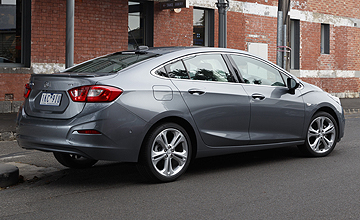BY DANIEL DEGASPERI | 15th Jun 2017

Holden wants the Astra sedan to be positioned as a more affordable alternative to the hatch, for buyers who prioritise space and comfort over sexiness and sportiness. The sedan starts at just $20,490 plus on-road for the Astra LS six-speed manual, only rising by $1000 for the six-speed automatic.
In both cases, this is $1000 cheaper than an equivalent Astra R hatch. Big ticket items are still present, such as an intuitive touchscreen with Apple CarPlay/Android Auto, reverse-view camera, rear parking sensors and automatic on/off headlights.
An identically priced Mazda3 Neo lacks a screen, camera and auto-lights, while a $300-cheaper Toyota Corolla Ascent misses the latter two features. A Hyundai Elantra Active is a better kit-match, but it costs $1460 more than this Holden.
Perhaps even more impressive is the auto-only $22,740 Astra LS+ sedan which adds a leather-trimmed steering wheel, forward collision warning, lane-departure warning with lane-keep steering assistance and auto high-beam.
It is a shame that autonomous emergency braking (AEB) is not available on any sedan, however, while the equivalent $23,740 Astra R+ hatch includes it.
Either way, it takes the $24,500-plus Mazda3 Maxx and Subaru Impreza 2.0i-L to pack as much safety gear, the former adding blind-spot monitoring but lacking lane-keep tech, while both lack auto high-beam but, crucially, add AEB. Hyundai and Toyota need to raise their game here.
The Astra sedan is also spacious, with generous rear legroom, a fold-down back armrest and a 445-litre boot spoiled only by luggage-crushing gooseneck bootlid hinges that were replaced by demonstrably superior gas-struts even in the Commodore of a decade ago.
Another trade-off compared with rivals – and even the Astra hatch – is cabin quality. Some variable trim-fit issues were noticed on some test cars at the national media launch, which does not make us feel at ease, given the low-quality reputation of the Cruze it replaces. However, Holden explained that some test vehicles were pre-production, and so the jury might have to be left outside for now.
Either way, the hard plastics that dominate the doors and dashboard are a decent step down from the Astra hatch, Mazda3, Corolla and Elantra.
The sedan follows its hatch stablemate in the steering, engine and transmission response, and – in the entry-level LS, in particular – suspension compliance and control.
Compared with the buzzy Mazda 2.0-litre four-cylinder and the only slightly less stolid Toyota 1.8-litre and Hyundai 2.0-litre units, Holden’s 1.4-litre direct injection turbo engine stands tall.
Smooth and ultra-responsive, with 240Nm (or 245Nm in the manual) produced from 2000rpm until 4000rpm, and 110kW at 6500rpm, it proves as compelling on-road as it is on paper. The auto intuitively grabs lower gears when braking downhill, holding them when travelling uphill, with drivetrain refinement and overtaking urge impressing even more than straight-line speed.
The locally tuned steering is as slick as the auto, too, with nice mid-weighting and a linear feel across the ratio. On the 16-inch Hankook tyres of the LS and LS+, the suspension also delivers on Holden’s promise of supple, soothing ride quality. Yet it is also finely controlled over even broken surfaces – and the launch outside of Byron Bay, New South Wales, certainly found plenty of those.
Impressive, too, was the respectable grip levels from both the Hankooks and the 17- and 18-inch Kumho Ecstas (on LT and LTZ model grades respectively) even on soaked surfaces. Korean tyres were once rubbished by Holden engineers who swapped them for Bridgestones when the Cruze became locally built. But they now claim they have improved substantially, which proved true.
Unfortunately, significant road roar is an ever-present Astra trait common in both sedan and hatch. Perhaps the former lacks the ultimate verve and agility of the latter, feeling more planted and solid in its handling, owing perhaps to the longer wheelbase or lack of extra rear suspension linkages.
A bigger issue for the LT and LTZ models concerns the slight degradation in ride compliance. Body control remains impeccable, but the top model on 18s especially lacks the insouciance of the entry model. The middle model on 17s, aptly, presents a decent middle ground, but either way an Astra hatch remains more cossetting on bigger wheels – in contrast to Holden’s aim.
Rise to the $25,790 LT and $29,790 LTZ and some of the Astra sedan’s value equation is lost along with the ride quality. For not much more, the RS and RS-V hatch offer a stronger 1.6-litre turbo engine and AEB, while the LT clings to integrated sat-nav and the LTZ to a sunroof as their calling cards. The cheaper cabin alone struggles to feel like value towards $30,000 before on-roads.
By some margin the Astra sedan shines brightest in LS and LS+ guise. Its drivetrain, steering and suspension are sophisticated enough to deserve sharing a name with the ‘proper’ Astra hatchback, and there is genuine cohesion between the two in the way they drive.
Yet by being cheaper inside, the Astra sedan can also tempt more pragmatic buyers with impressive space and equipment for less. Hopefully, the build quality and durability does the name justice.
The answer to the original question, then, is that the Holden Astra sedan is both like and unlike the hatch. That could be a good thing, though, as different bodystyles should also appease different buyers. And thankfully the LS and LS+ are particularly good things.